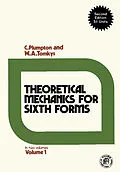Theoretical Mechanics for Sixth Forms, Second Edition is a 14-chapter book that begins by elucidating the nature of theoretical mechanics. The book then describes the statics of a particle in illustration of the techniques of handling vector quantities. Subsequent chapters focus on the principle of moments, parallel forces and centers of gravity; and the application of Newton's second law to the dynamics of a particle and the ideas of work and energy, impulse and momentum, and power. The concept of friction is also explained. This volume concludes with chapters concerning motion in a circle and simple harmonic motion.
This text will serve as a more complete course for pupils taking mathematics as a single or double subject.
Inhalt
Preface
Chapter I. Introduction. The Fundamental Concepts of Theoretical Mechanics
1.1. The Nature of Theoretical Mechanics
1.2. Newton's Axioms
1.3. The Unit of Mass and the Unit of Force
1.4. Gravitational Units of Force
Chapter II. Systems of Coplanar Forces Acting on a Particle
2.1. Vector Quantities
2.2. Velocities and Accelerations as Vectors
2.3. Force as a Vector
2.4. The Parallelogram of Forces
2.5. Equilibrium of Forces
2.6. Forces in the Physical World
2.7. The Resultant of Any Number of Forces Acting on a Particle
2.8. The Equilibrium of a Rigid Body Acted Upon by Three Forces Only
2.9. Two Useful Trigonometric Formula
2.10. Elastic Strings
2.11. Particles Suspended from a String
Chapter III. The Kinematics of a Particle Moving in a Straight Line
3.1. Relationships between Distance, Time, Velocity and Acceleration
3.2. Graphical Relationships
3.3. Uniformly Accelerated Motion in a Straight Line
3.4. Free Motion under Gravity
Chapter IV. Projectiles
4.1. The Resolution of Uniplanar Motion into Components at Right Angles
4.2. The Free Motion of a Projectile
4.3. The Equation of the Path
4.4. The Parabolic Path of a Projectile
4.5. The Range on an Inclined Plane
Chapter V. Relative Motion
5.1. Relative Position
5.2. Relative Velocity
5.3. Problems of Relative Position and Interception
Chapter VI. The Moment of a Force
6.1. The Law of the Lever
6.2 The Resultant of a System of Parallel Forces
6.3 Equilibrium of a Rigid Body Acted Upon by a System of Coplanar Forces
6.4 Graphical Representation of the Moment of a Force
Chapter VII. Centers of Gravity
7.1. Definition
7.2. The Center of Gravity of a Finite Number of Coplanar Particles
7.3. The Center of Gravity of a Rigid Body
7.4. The Center of Gravity of a Compound Body
7.5. The Position of a Freely Suspended Body
7.6. The Equilibrium of a Body at Rest on a Horizontal Plane
7.7. The Centers of Gravity of Some Common Solids
Chapter VIII. The Dynamics of a Particle
8.1. Newton's Laws of Motion
8.2. The Motion of Connected Particles
8.3. Impulse and Momentum
8.4. Conservation of Momentum
8.5. Work and Energy
Chapter IX. Friction
9.1. The Nature of Friction
9.2. The Laws of Friction
9.3. The Angle of Friction
9.4. The Equilibrium of a Particle on an Inclined Plane
9.5. Examples Involving Friction
Chapter X. Conservation of Energy
10.1. Energy in the Physical World
10.2. Conservation of Mechanical Energy
10.3. The Relation between the Energy Equation and the Equation of Motion
Chapter XI. The Impact of Elastic Bodies
11.1. Direct Collision of Elastic Spheres
11.2. Impulsive Reaction and Loss of Kinetic Energy
11.3. The Collision between a Smooth Sphere and a Fixed Smooth Plane
11.4. Oblique Impact of Smooth Elastic Spheres
Chapter XII. Power
12.1. Definition and Units
12.2. Power with a Constant Force
12.3. Energy and Power
12.4. The Acceleration and the Maximum Speed of a Car
Chapter XIII. Motion in a Circle
13.1. The Motion of a Particle Which is Not Moving in a Straight Line
13.2. Angular Velocity and Angular Acceleration
13.3. Uniform Speed in a Circle
13.4. Some Examples of Uniform Circular Motion in a Horizontal Circle
13.5. Motion in a Circle When the Speed is Not Necessarily Uniform
13.6. Motion in a Vertical Circle
Chapter XIV. Simple Harmonic Motion
14.1. Some Oscillatory Motions
14.2. The Solution of the Equation of SHM
14.3. Two Particular Integrals of the SHM Equation
14.4. The Projection of Uniform Motion in a Circle on to a Diameter
14.5. The Motion of a Particle Attached to a Light Elastic Spring
14.6. The Motion of a Particle Attached to Two Elastic Strings
14.7. Problems Involving the Equation of Motion =- 2x+c
14.8. The Motion of the Center of Mass of Two Moving Particles
14.9. The Rectilinear Motion in a Horizontal Plane of Two Particles Which are Connected by an Elastic Spring
14.10. Small Oscillations
Answers To the Exercises
Index
